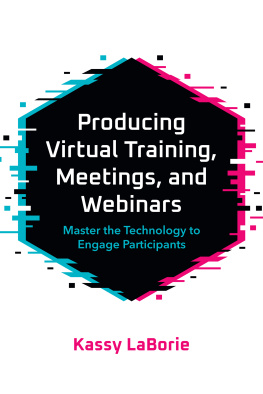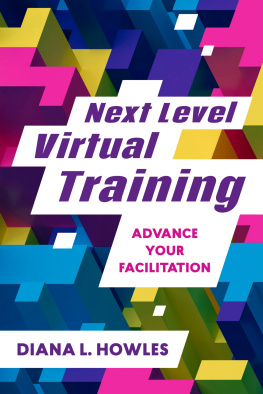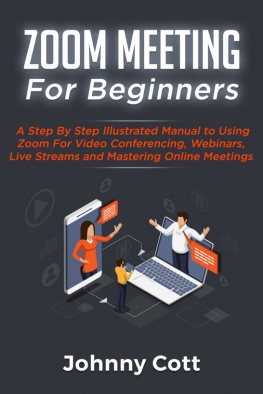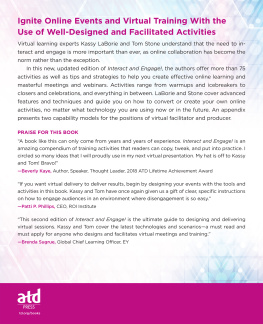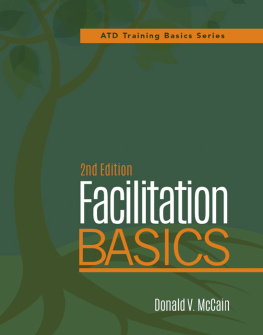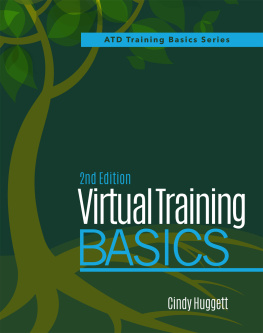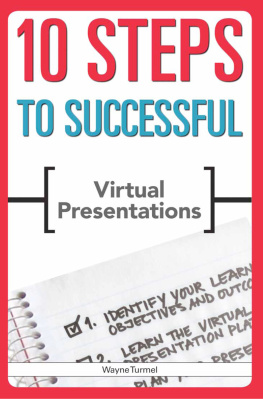All rights reserved. Printed in the United States of America.
No part of this publication may be reproduced, distributed, or transmitted in any form or by any means, including photocopying, recording, information storage and retrieval systems, or other electronic or mechanical methods, without the prior written permission of the publisher, except in the case of brief quotations embodied in critical reviews and certain other noncommercial uses permitted by copyright law. For permission requests, please go to copyright.com, or contact Copyright Clearance Center (CCC), 222 Rosewood Drive, Danvers, MA 01923 (telephone: 978.750.8400; fax: 978.646.8600).
ATD Press is an internationally renowned source of insightful and practical information on talent development, training, and professional development.
Foreword
Ive known Kassy LaBorie for the better part of the last decade. Like many of the L&D professionals I see often at industry events, its difficult to pinpoint the first time we met, but I do vividly recall one of our early interactions that built the strong respect and admiration I have for Kassy and her work.
When Kassy was at Dale Carnegie, there was a role being filled that I was interested in. It was a role tied to the organizations increased focus on using digital technologies, and Kassy and I spent a good amount of time talking about the company, the new focus, andmost important to the context hereher role in what was being built.
It was one of the first opportunities I had to really listen to Kassy talk about her work in detail. Unlike the well-rehearsed conference presentations I had seen in the past, this was just two L&D people talking shop. She described the work she was doing and what she was hoping to do in the future. Her passion was contagious, and our talks left me excited for the possibility of working together. I remember leaving one of our first discussions thinking, This is someone who really gets it.
While that opportunity to work together didnt come to pass, I like to think I did get the chance to work with Kassy through her first book, Interact andEngage! 50+ Activities for Virtual Training. Meetings, and Webinars, co-authored with Tom Stone.
At the time the book was published, I was supporting the technology-based learning efforts of a local nonprofit. Much of the live training I supported used Webex, so Kassy and Toms book was always on the shelf above my desk, ready to be referenced as I looked for interesting and engaging activities to include in the sessions I was building. Its a book that has plenty of highlights, earmarked pages, and Post-It flags sticking out of it as a testament to the practical solutions it provides me, and it still resides on my bookshelf today.
My personal journey as a learning and development professional took an unexpected turn almost a decade ago when I had the opportunity to join the eLearning Guild, known today as The Learning Guild. My work at the guild includes supporting our webinars and online conferences, and it has definitely made me look at a side of virtual sessions that Ilike many in L&Dhad not prioritized enough in my work: production.
For many of us, producing a virtual session simply means that we press start and hope it works out. Ive lost count of how many sessions Ive conducted, from design to technology-supported delivery, all on my own. While I was producing these sessions, in hindsight that production wasnt strategic or intentional; it was producing as defined simply by the technical requirements of making the virtual session happen.
It wasnt until I joined the guild, and began working with expert virtual session professionals, that I truly discovered what virtual session production means. One of the first things I noticed wasnt the feedback I got on our speakers; it was the feedback I got from our speakers, talking about how much the process used by our team made things run smoothly, allowing them to focus less on the technical administration and more on the learning experience.
There is so much that our virtual session producers and hosts do that had never been on my radar before, from the way they prepare speakers and attendees, to designing room layouts, to troubleshooting. Its all part of a strategic and intentional approach that raises the bar for virtual session production, increasing trainers ability to deliver learning and performance outcomes in the process.
Had it not been for my work at the guild, Im not sure if I would ever have understood just how important virtual session production is, and why it is its own critical skill set above and beyond whats required to facilitate a virtual session. But theres never been a resource that narrowly focused on the ins and outs of the production side of virtual sessions, emphasizing its importance in the work that we do as learning professionals.
Until now.
Producing Virtual Training, Meetings, and Webinars is the definitive guide for building a virtual session production strategy. It explores what makes a producers role different than that of a presenter, the skills required to deliver upon that value, and the specific tasks that get delivered each step of the way. This book is a must-read not just for those who are interested in exploring a career as a virtual session producer, but for anyone whose work involves supporting virtual events.
I want to personally thank Kassy for placing a spotlight on an important role that doesnt get enough attention in our industry. Its my hope that by reading this book, and sharing it with our peers, we can greatly improve the virtual sessions we produce as an industry.
David Kelly
Executive Vice President and Executive Director
The Learning Guild
December 2020
Introduction
Virtual trainers, online meeting hosts, and webinar presenters, we have a problem: Engagement.
Web conferencing software allows people to deliver and participate in meetings, training, and other types of online sessions using their computer and an internet connection. This software is easy to come by in todays world, and meeting online is now a regular part of everyday work life for most people. This was already becoming increasingly true through early 2020, but during the COVID-19 pandemic such platforms exploded in popularity to support the significant increase in remote workers and virtual teams.
Even with such increased use, engaging virtual classroom learners, meeting participants, and webinar attendees is often a challenge. The list of reasons why is long, likely beginning with the presenter and the content, but almost always including problems with web conferencing software itself. In addition to planning, designing, and delivering engaging experiences, virtual presenters have to master the management of the technical side of this experience. This is generally referred to as the production of the virtual event or session.

